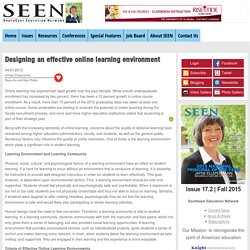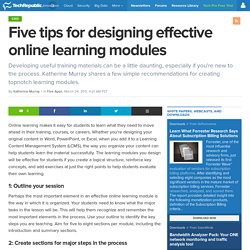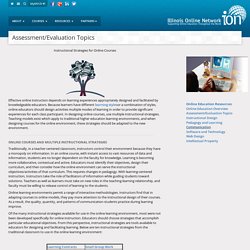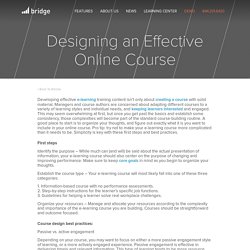

10 Online Training Do's and Don'ts. There are many things to think about when creating an eLearning team and creating online training.

This posts list 10 DOs and DON’Ts to consider when building your next team and course. It isn’t a complete list but it does cover the main bases. You can also checkout the animated presentation. Feel free to leave comments on sections that we should add. 1. Now-a-days, almost every training course has a PowerPoint (PPT). 2. Just because someone is an expert at selling the product doesn’t mean that they can design training. Instructional Designer (ID) The ID is in charge of getting all of the information out of the SMEs head. Designer The designer must take the paper concept of the course and make it come to life. 3. Viewcontent. Designing an effective online learning environment. Along with the increasing demands of online learning, concerns about the quality of distance learning have remained among higher education administrators, faculty, and students, as well as the general public.

Numerous factors may influence the quality of online instruction. Five tips for designing effective online learning modules. Online learning makes it easy for students to learn what they need to move ahead in their training, courses, or careers.

Whether you're designing your original content in Word, PowerPoint, or Excel, when you add it to a Learning Content Management System (LCMS), the way you organize your content can help students learn the material successfully. The learning modules you design will be effective for students if you create a logical structure, reinforce key concepts, and add exercises at just the right points to help students evaluate their own learning. 1: Outline your session Perhaps the most important element in an effective online learning module is the way in which it is organized. Your students need to know what the major tasks in the lesson will be.
Characteristics of Effective Online Assignments. Effective online assignments and activities typically... ...take advantage of the Web as a learning environment The Web offers a wealth of information, services, and tools that can be incorporated into assignments and course activities; you can use its networked, hypertextual nature to stimulate curiosity, encourage exploration, and promote critical thinking.

There is no need to be constrained by the limitations of specific learning platforms when developing online assignments. ...start engaging students early in the course The first assignment is a good indicator of whether a student will complete the course. ...are transparent in their motives and articulate a clear rationale All assignments benefit from a clearly articulated rationale, but this is especially true online, where it can be more difficult for students to ask clarifying questions. ...connect multiple parts of the course. Instructional Strategies for Online Courses. Instructional Strategies for Online Courses Effective online instruction depends on learning experiences appropriately designed and facilitated by knowledgeable educators.

Because learners have different learning stylesor a combination of styles, online educators should design activities multiple modes of learning in order to provide significant experiences for each class participant. In designing online courses, use multiple instructional strategies. Teaching models exist which apply to traditional higher education learning environments, and when designing courses for the online environment, these strategies should be adapted to the new environment. Traditionally, in a teacher-centered classroom, instructors control their environment because they have a monopoly on information. MS05007_002. Ten Best Practices for Teaching Online. J.

V. Boettcher, Ph.D. Designing for Learning 2006 - 2013 Minor revisions May 2011 Our knowledge about what works well in online teaching and learning is growing rapidly and that is very good news. Here are ten best practices for anyone just getting started in the online environment. Best Practice 1: Be Present at the Course Site Liberal use of a faculty's use of communication tools such as announcements, discussion board postings, and forums communicate to the students that the faculty member cares about who they are, cares about their questions and concerns, and is generally "present" to do the mentoring and challenging that teaching is all about. When faculty actively interact and engage students in a face-to-face classroom, the class develops as a learning community, developing intellectual and personal bonds.
We have learned to quantify what it means to "be present. " Note: Students who feel abandoned or who feel alone may even post questions, such as "Is anybody there? " References. Designing Effective E-learning/Online Training Courses. Developing effective e-learning training content isn’t only about creating a course with solid material.

Managers and course authors are concerned about adapting different courses to a variety of learning styles and individual needs, and keeping learners interested and engaged. This may seem overwhelming at first, but once you get past the basics and establish some consistency, those complexities will become part of the standard course-building routine. Higher Ed Program > Rubric. The Quality Matters Higher Education Rubric, Fifth Edition, 2014 is a set of 8 General Standards and 43 Specific Review Standards used to evaluate the design of online and blended courses.

The Rubric is complete with Annotations that explain the application of the Standards and the relationship among them. Understanding-Virtual-Pedagogies_CKC_ideasLAB.pdf.